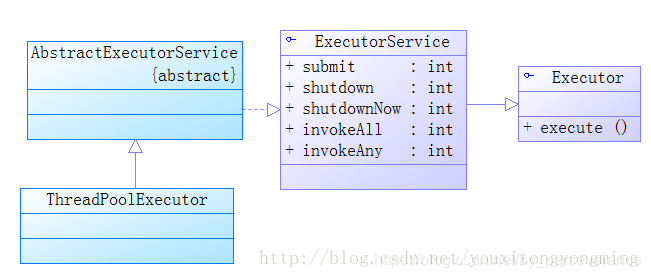-
初识线程池
1、概述
线程池是一种多线程处理形式,处理过程中将任务提交到线程池,任务的执行交由线程池来管理。Java中的线程池是运用场景最多的并发框架,几乎所有需要异步或并发执行任务的程序都可以使用线程池。
2、好处
1)降低资源消耗。通过重复利用已创建的线程降低线程创建和销毁造成的消耗。
2)提高响应速度。当任务到达时,任务可以不需要等到线程创建就能立即执行。
3)提高线程的可管理性。线程是稀缺资源,如果无限制地创建,不仅会消耗系统资源,还会降低系统的稳定性,使用线程池可以进行统一分配、调优和监控。
-
线程池的作用
线程池是为突然大量爆发的线程设计的,通过有限的几个固定线程为大量的操作服务,减少了创建和销毁线程所需的时间,从而提高效率。
如果一个线程的时间非常长,就没必要用线程池了(不是不能作长时间操作,而是不宜。),况且我们还不能控制线程池中线程的开始、挂起、和中止。
-
Java中的ThreadPoolExecutor类剖析
1、ThreadPoolExecutor类的四个构造方法
public class ThreadPoolExecutor extends AbstractExecutorService { public ThreadPoolExecutor(int corePoolSize, int maximumPoolSize, long keepAliveTime, TimeUnit unit, BlockingQueue<Runnable> workQueue); public ThreadPoolExecutor(int corePoolSize, int maximumPoolSize, long keepAliveTime, TimeUnit unit, BlockingQueue<Runnable> workQueue, ThreadFactory threadFactory); public ThreadPoolExecutor(int corePoolSize, int maximumPoolSize, long keepAliveTime, TimeUnit unit, BlockingQueue<Runnable> workQueue, RejectedExecutionHandler handler); public ThreadPoolExecutor(int corePoolSize, int maximumPoolSize, long keepAliveTime, TimeUnit unit, BlockingQueue<Runnable> workQueue, ThreadFactory threadFactory, RejectedExecutionHandler handler); }2、构造器中的参数含义
corePoolSize:核心池的大小,这个参数跟后面讲述的线程池的实现原理有非常大的关系。在创建了线程池后,默认情况下,线程池中并没有任何线程,而是等待有任务到来才创建线程去执行任务,默认情况下,在创建了线程池后,线程池中的线程数为0,当有任务来之后,就会创建一个线程去执行任务,当线程池中的线程数目达到corePoolSize后,就会把到达的任务放到缓存队列当中。可以调用prestartAllCoreThreads()或者prestartCoreThread()方法预创建线程;
maximumPoolSize:线程池最大线程数,这个参数也是一个非常重要的参数,它表示在线程池中最多能创建多少个线程;
keepAliveTime:表示线程没有任务执行时最多保持多久时间会终止。默认下只有当线程池中的线程数大于corePoolSize时,keepAliveTime才会起作用,直到线程池中的线程数不大于corePoolSize,即当线程池中的线程数大于corePoolSize时,如果一个线程空闲的时间达到keepAliveTime,则会终止,直到线程池中的线程数不超过corePoolSize。但是如果调用了allowCoreThreadTimeOut(boolean)方法,在线程池中的线程数不大于corePoolSize时,keepAliveTime参数也会起作用,直到线程池中的线程数为0;
unit:参数keepAliveTime的时间单位,有7种取值,在TimeUnit类中有7种静态属性,如下:
NANOSECONDS 纳秒 MICROSECONDS 微妙 MILLISECONDS 毫秒 SECONDS 秒 MINUTES 分钟 HOURS 小时 DAYS 天 workQueue:一个阻塞队列,用来存储等待执行的任务,这个参数的选择也很重要,会对线程池的运行过程产生重大影响,一般来说,这里的阻塞队列有以下几种选择:ArrayBlockingQueue、LinkedBlockingQueue、PriorityBlockingQueue、SynchronousQueue。第二、四使用较多,线程池的排队策略与BlockingQueue有关;
threadFactory:线程工厂,主要用来创建线程;
handler:表示当拒绝处理任务时的策略,有以下四种取值:
ThreadPoolExecutor.AbortPolicy 丢弃任务并抛出RejectedExecutionException异常 ThreadPoolExecutor.DiscardPolicy 也是丢弃任务,但是不抛出异常 ThreadPoolExecutor.DiscardOldestPolicy 丢弃队列最前面的任务,然后重新尝试执行任务(重复此过程) ThreadPoolExecutor.CallerRunsPolicy 由调用线程处理该任务 3、类结构
详解:https://blog.youkuaiyun.com/youxitongyongming/article/details/77751874
-
创建线程池的四种方式
Java通过java.util.concurrent.Executors(jdk1.5并发包)类中的方法提供四种线程池
1、newCachedThreadPool
API:
public static ExecutorService newCachedThreadPool() { return new ThreadPoolExecutor(0, Integer.MAX_VALUE, 60L, TimeUnit.SECONDS, new SynchronousQueue<Runnable>()); } public static ExecutorService newCachedThreadPool(ThreadFactory threadFactory) { return new ThreadPoolExecutor(0, Integer.MAX_VALUE, 60L, TimeUnit.SECONDS, new SynchronousQueue<Runnable>(), threadFactory); }说明:创建一个可缓存线程池,如果线程池长度超过处理需要,可灵活回收空闲线程,若无可回收,则新建线程
代码:
public class NewCacheThreadPoolTest { public static void main(String[] args) { ExecutorService newCachedThreadPool = Executors.newCachedThreadPool(); for (int i = 0; i < 10; i++) { final int temp = i; newCachedThreadPool.execute(new Runnable() { @Override public void run() { try { // Thread.sleep(100); } catch (Exception e) { // TODO: handle exception } System.out.println(Thread.currentThread().getName() + ",i:" + temp); } }); } } }运行结果:
pool-1-thread-1,i:0 pool-1-thread-2,i:1 pool-1-thread-6,i:5 pool-1-thread-6,i:9 pool-1-thread-3,i:2 pool-1-thread-7,i:6 pool-1-thread-4,i:3 pool-1-thread-8,i:7 pool-1-thread-1,i:8 pool-1-thread-5,i:4总结:
线程池为无限大,当执行第二个任务时第一个任务已经完成,会复用执行第一个任务的线程,而不用每次新建线程。
2、newFixedThreadPool
API:
public static ExecutorService newFixedThreadPool(int nThreads) { return new ThreadPoolExecutor(nThreads, nThreads, 0L, TimeUnit.MILLISECONDS, new LinkedBlockingQueue<Runnable>()); } public static ExecutorService newFixedThreadPool(int nThreads, ThreadFactory threadFactory) { return new ThreadPoolExecutor(nThreads, nThreads, 0L, TimeUnit.MILLISECONDS, new LinkedBlockingQueue<Runnable>(), threadFactory); }说明:创建一个定长线程池,可控制线程最大并发数,超出的线程会在队列中等待。
代码:
public class NewFixedThreadPoolTest { public static void main(String[] args) { ExecutorService newFixedThreadPool = Executors.newFixedThreadPool(5); for (int i = 0; i < 10; i++) { final int temp = i; newFixedThreadPool.execute(new Runnable() { @Override public void run() { System.out.println(Thread.currentThread().getId() + ",i:" + temp); } }); } } }运行结果:
10,i:0 11,i:1 12,i:2 14,i:4 14,i:5 13,i:3 13,i:6 13,i:7 14,i:9 10,i:8总结:
因为线程池大小为3,每个任务输出index后sleep 2秒,所以每两秒打印3个数字。定长线程池的大小最好根据系统资源进行设置。如Runtime.getRuntime().availableProcessors()。
3、newScheduledThreadPool
API:
public static ScheduledExecutorService newScheduledThreadPool(int corePoolSize) { return new ScheduledThreadPoolExecutor(corePoolSize); } public static ScheduledExecutorService newScheduledThreadPool( int corePoolSize, ThreadFactory threadFactory) { return new ScheduledThreadPoolExecutor(corePoolSize, threadFactory); }说明:创建一个定长线程池,支持定时及周期性任务执行。[可定时的线程池]
代码:
public class NewScheduledThreadPoolTest { public static void main(String[] args) { ScheduledExecutorService newScheduledThreadPool = Executors.newScheduledThreadPool(5); for (int i = 0; i < 10; i++) { final int temp = i; newScheduledThreadPool.schedule(new Runnable() { public void run() { System.out.println("i:" + temp); } }, 3, TimeUnit.SECONDS); } } }schedule(Runnable command, long delay, TimeUnit unit),schedule方法被用来延迟指定时间后执行某个指定任务。
command:定时任务 ,delay:延迟时间 ,unit:时间单位 。
4、newSingleThreadExecutor
API:
public static ExecutorService newSingleThreadExecutor() { return new FinalizableDelegatedExecutorService (new ThreadPoolExecutor(1, 1, 0L, TimeUnit.MILLISECONDS, new LinkedBlockingQueue<Runnable>())); } public static ExecutorService newSingleThreadExecutor(ThreadFactory threadFactory) { return new FinalizableDelegatedExecutorService (new ThreadPoolExecutor(1, 1, 0L, TimeUnit.MILLISECONDS, new LinkedBlockingQueue<Runnable>(), threadFactory)); }说明:创建一个单线程化的线程池,它只会用唯一的工作线程来执行任务,保证所有任务按照指定顺序(FIFO, LIFO, 优先级)执行。
代码:
public class NewSignleThreadExecutorTest { public static void main(String[] args) { ExecutorService newSingleThreadExecutor = Executors.newSingleThreadExecutor(); for (int i = 0; i < 10; i++) { final int index = i; newSingleThreadExecutor.execute(new Runnable() { @Override public void run() { System.out.println("index:" + index); try { Thread.sleep(200); } catch (Exception e) { // TODO: handle exception } } }); } } }注意:结果依次输出,相当于顺序执行各个任务。





 本文深入解析Java线程池的原理与应用,包括ThreadPoolExecutor类的构造方法、参数意义及四种常见线程池的创建方式,帮助读者理解线程池如何提升程序效率。
本文深入解析Java线程池的原理与应用,包括ThreadPoolExecutor类的构造方法、参数意义及四种常见线程池的创建方式,帮助读者理解线程池如何提升程序效率。

















 1077
1077

 被折叠的 条评论
为什么被折叠?
被折叠的 条评论
为什么被折叠?








